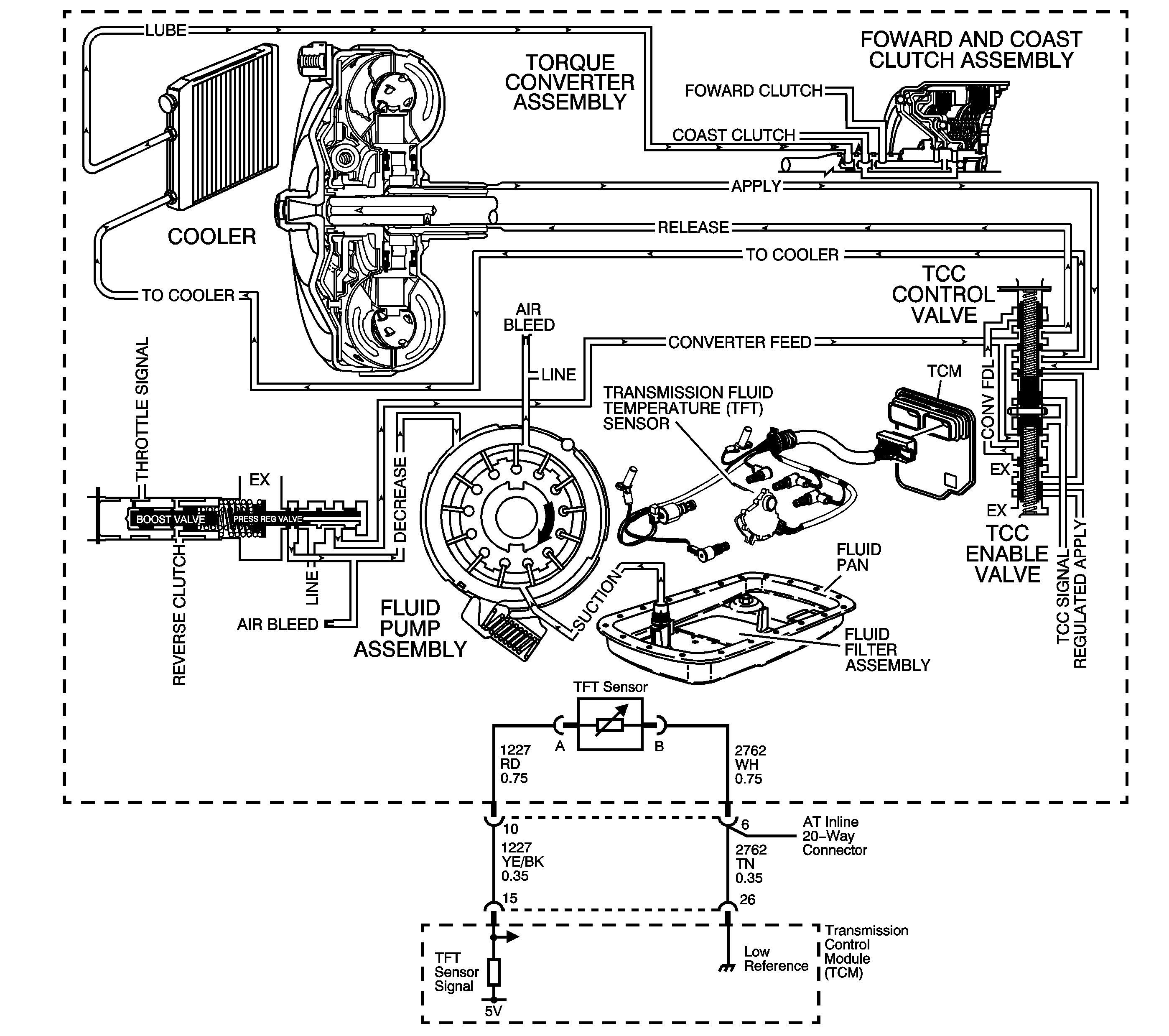
Circuit Description
The primary source of heat in the transmission is the torque converter. Hot oil exits the torque converter through the torque converter clutch (TCC) control valve and flows to the transmission cooler supply line. The supply line connects to the cooler, which is located in the radiator. From the cooler, the oil returns through the oil cooler return line and enters the lubrication circuits. After lubricating the internal components, the oil then returns to the oil pan. The oil pump draws oil through the filter from the oil pan, where the transmission fluid temperature (TFT) sensor is located. The oil pump pressurizes the oil and directs it to the pressure regulator valve. The pressure regulator valve is the starting point for the main supply of oil to the torque converter and the transmission hydraulic components.
When the transmission control module (TCM) detects high transmission oil temperature for an extended period of time, DTC P0218 sets. DTC P0218 is a type C DTC.
Conditions for Running the DTC
The transmission fluid temperature is -39 to +149°C (-38 to +300°F) for greater than 5 seconds.
Conditions for Setting the DTC
The transmission fluid temperature is greater than 132°C (270°F) for 600 seconds (10 minutes).
Action Taken When the DTC Sets
| • | The TCM does not request the engine control module (ECM) to illuminate the malfunction indicator lamp (MIL). |
| • | TRANSMISSION HOT - IDLE ENGINE displays on the driver information center (DIC). |
| • | The TCM freezes transmission adaptive functions. |
| • | The TCM records the operating conditions when the Conditions for Setting the DTC are met. The TCM records this information as a Failure Record. |
| • | The TCM stores DTC P0218 in TCM history. |
Conditions for Clearing the DIC/DTC
| • | The TCM clears the DIC message when the condition no longer exists. |
| • | The TCM cancels the DTC default actions when the condition no longer exists. |
| • | The TCM clears the DTC from TCM history if the vehicle completes 40 warm-up cycles without a non emission related diagnostic fault occurring. |
| • | A scan tool can clear the DTC. |
Diagnostic Aids
| • | The DIC, if equipped, will display TRANSMISSION HOT - IDLE ENGINE when the transmission fluid temperature reaches 132°C (270°F). |
| • | Observe DIC messaging that would indicate the engine cooling system is hot. |
| • | The TFT displayed on the scan tool should rise steadily to a normal operating temperature, then stabilize. |
| • | Ask about the customer's driving habits, trailer towing, etc. Trailer towing should occur in D4. |
Step | Action | Value(s) | Yes | No |
|---|---|---|---|---|
1 | Did you perform the Diagnostic System Check - Vehicle? | -- | Go to Step 2 | Go to Diagnostic System Check - Vehicle in Vehicle DTC Information |
2 |
Important: Record the Failure Records before clearing the DTC. Using the Clear Info function erases the Failure Records from the ECM and the TCM. Is the engine coolant temperature above the specified value when the DTC set? | 125°C (257°F) | Go to Engine Overheating in Engine Cooling | Go to Step 3 |
3 |
Is the action complete? | -- | Go to Step 4 | -- |
4 |
Did you find and correct a condition? | -- | Go to Step 7 | Go to Step 5 |
5 |
Did you find and correct a condition? | -- | Go to Step 7 | Go to Step 6 |
6 |
Did you find and correct a condition? | -- | Go to Step 7 | -- |
7 | Perform the following procedure in order to verify the repair:
Has the test run and passed? | -- | Go to Step 8 | Go to Step 2 |
8 | With the scan tool, observe the stored information, capture info and DTC info. Does the scan tool display any DTCs that you have not diagnosed? | -- | Go to Diagnostic Trouble Code (DTC) List - Vehicle in Vehicle DTC Information | System OK |
